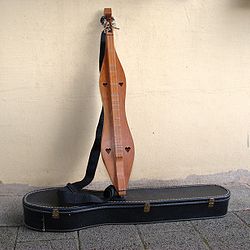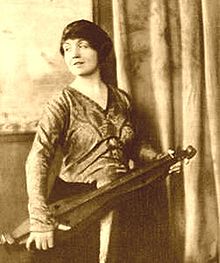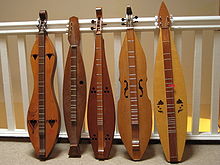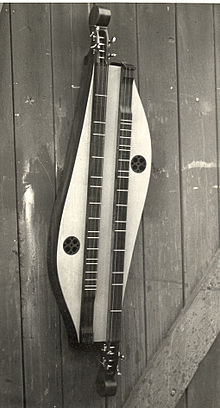- Appalachian dulcimer
-
Appalachian dulcimer 
Other names Mountain dulcimer, lap dulcimer, fretted dulcimer, Classification Related instruments - Epinette des Vosges (France)
- Langeleik (Norway)
- Scheitholt (Germany)
- Hummel (instrument) (Netherlands)
- Monochord
- Zither
The Appalachian dulcimer (or mountain dulcimer) is a fretted string instrument of the zither family, typically with three or four strings. It is native to the Appalachian region of the United States. The body extends the length of the fingerboard, and its fretting is generally diatonic.
Contents
Origins and history
Although the Appalachian dulcimer first appeared in the early 19th century among Scots-Irish immigrant communities in the southern Appalachian Mountains, the instrument has no known precedent in Ireland or Scotland.[citation needed] However, several diatonic fretted zithers exist in Continental Europe that have a strong similarity to the dulcimer. Jean Ritchie and others[citation needed] have speculated the Appalachian dulcimer is related to similar European instruments like the langeleik, scheitholt and épinette des Vosges.
Charles Maxson, an Appalachian luthier from Volga, WV, speculated that early settlers were unable to make the more complex violin in the early days due to lack of tools and time. This was one of the factors which led to the building of the dulcimer, which has less dramatic curves. He too cited the langeleik, scheitholt and épinette des Vosges as ancestor instruments. He built at least one of each.
Few true specimens of the mountain dulcimer exist from earlier than about 1880, when J. Edward Thomas of Knott County, Ky began building and selling them. The instrument became used as something of a parlor instrument, as its modest sound volume is best-suited to small home gatherings. But for the first half of the 20th century the mountain dulcimer was rare, with a handful of makers supplying players in scattered pockets of Appalachia. Virtually no audio recordings of the instrument exist from earlier than the late 1930s.
The Appalachian dulcimer achieved a renaissance in the 1950s urban folk music revival in the United States through the work of Jean Ritchie, a Kentucky musician who introduced the instrument to New York City audiences.[citation needed] In the early 1960s, Ritchie and her partner George Pickow began distributing dulcimers made by her Kentucky relative Jethro Amburgey, then the woodworking instructor at the Hindman Settlement School. They eventually began producing their own instruments in New York City. Meanwhile, the American folk musician Richard Fariña (1937–1966) was also bringing the Appalachian dulcimer to a much wider audience, and by 1965 the instrument was a familiar presence in folk music circles.
In addition to Amburgey, by then winding down his production, influential builders of mid-1960s included Homer Ledford, Lynn McSpadden, A. W. Jeffreys and Joellen Lapidus. In 1969 Michael and Howard Rugg formed a company called Capritaurus. As well as being the first to mass-produce the instrument, they made design changes to make it both easier produce and to play. The body was made larger, and they installed guitar tuners to make tuning easier for players. This became known as the "California style" dulcimer.
Playing
 Closeup of Aubrey Atwater playing dulcimer.
Closeup of Aubrey Atwater playing dulcimer.
The traditional way to play the instrument is to lay it flat on the lap and pluck or strum the strings with the right hand, while fretting with the other. The dulcimer may also be placed in a similar position on a piece of furniture, such as a table or chest of drawers, to enhance the sound. There are two predominant methods of fretting. First, the strings may be depressed with the fingertips of the fretting hand. Using this technique, all the strings may be fretted, allowing the player to produce chords. Second, the melody string, the string closest to the player, may be depressed with a "noter," typically a short length of dowel or bamboo (see photo at left). Using this method, only the melody string is fretted and the other strings act as drone strings (the melody string may be doubled, so that the melody can be better heard over the drones). In this second style of playing, the combination of the drone strings and the buzz of the noter on the melody strings produces a unique sound.
In practice, a wide variety of playing styles have long been used. Jean Ritchie's The Dulcimer Book[1] has an old photograph of Mrs. Leah Smith of Big Laurel, Kentucky, playing the dulcimer with a bow instead of a pick, with the tail of the dulcimer held in the player's lap, and the headstock resting on a table pointing away from her. In their book In Search of the Wild dulcimer,[2] Robert Force and Al d'Ossché describe their preferred method as "guitar style": The dulcimer hangs from a strap around the neck, and the instrument is fretted and strummed like a guitar. They also describe playing "autoharp style" where "the dulcimer is held vertically with the headstock over the shoulder." Lynn McSpadden, in his book Four and Twenty Songs for the Mountain Dulcimer,[3] states that some players "tilt the dulcimer up sideways on their laps and strum in a guitar style." Still other dulcimer players use a fingerstyle technique, fingering chord positions with the fretting hand and rhythmically plucking individual strings with the strumming hand, creating delicate arpeggios.
Contemporary players have also borrowed from chord theory and guitar analogues to create a variety of more complex ways to play the dulcimer. Some dulcimers are constructed with four equidistant strings to facilitate playing more complex chords, particularly for playing jazz. In another line of contemporary innovation, electric dulcimers have been used in rock music. The Appalachian dulcimer is both easy to learn to play, and capable of complexity, providing scope for a wide range of professionals and hobbyists.[citation needed]
Strings, frets and tuning
The frets of the Appalachian dulcimer are typically arranged in a diatonic scale. Traditionally, the Appalachian dulcimer was usually tuned to DAA, or notes with this I V V relationship.[4] That is, the key note is on the bass string and the middle and melody strings are at an interval of a perfect fifth above it. The melody string is tuned so that the key note is at the third (diatonic) fret. This facilitates playing melodies in the Ionian mode (the major scale). The melody is played on the top string (or string pair) only, with the unfretted drone strings providing a simple harmony, giving the instrument its distinctive traditional sound. To play in a different key, or in a different mode, a traditional player would have to retune the instrument. For example, to play a minor mode melody the instrument might be tuned to DAC. This facilitates playing the Aeolian mode (the natural minor scale), where the scale begins at the first fret.
 A photo from the May 1, 1917, issue of Vogue, featuring an Appalachian dulcimer.
A photo from the May 1, 1917, issue of Vogue, featuring an Appalachian dulcimer.
Modern instruments usually include an additional fret, a half step below the octave position, the so-called "six and a half" fret. This enables one to play in the Ionian mode when tuned to DAD, the traditional tuning for the Mixolydian mode, where the scale starts on the open fret. This arrangement is often found to be more conducive to chordal playing, as opposed to the more traditional dronal style. Among modern players, it is fair to say that the instrument is most commonly tuned to DAD.[citation needed] So-called "chromatic dulcimers," with twelve frets per octave, are sometimes made, to permit playing in any key without re-tuning.
While the most common current tuning is DAD, it is often easier for the beginning player to tune to DAA or the so-called "Reverse Ionian" tuning, DGD. "Reverse" tunings are ones in which the key note is on the middle string and the bass string is the fifth of the scale, but in the octave below the middle string. This is sometimes[by whom?] suggested as an easier tuning. From DGD one can put a capo on the first fret to play in the Dorian mode, or retune the second string (to A), to play in the Mixolydian mode, then from Mixolydian, capo the first fret to play in the Aeolian mode. DAA tuning should not be thought of as simply a "beginner's" tuning, however. Many accomplished, innovative players use this tuning.[citation needed]
Contemporary Usage
The Appalachian dulcimer is now a core instrument found in the American old-time music tradition. But styles performed by modern dulcimer enthusiasts run the gamut from traditional folk music through popular and experimental forms, although most perform in more-or-less traditional styles. Some players exploit its similarity in tone to certain Middle Eastern and Asian instruments. Increasingly, modern musicians such as Lindsay Buckland, Bing Futch, Butch Ross, Cristian Huet in France and Quintin Stephens have contributed to the popularity of the solid-body electric dulcimer. Dulcimer festivals take place regularly in the United States, Canada, the United Kingdom, and Ireland, as the Appalachian dulcimer has achieved a following in a number of countries.[citation needed]
Though the mountain dulcimer has long been associated with the elder generation, it has gradually attracted a number of younger players who have discovered its charms. Due to its ease of play, many music teachers consider it to be an especially good educational instrument.[citation needed] Because of this, they are often used in educational settings, and some music classes make their own dulcimers. However, because of budget, time, and craftsmanship skill issues, these are usually made from cardboard.
One of the most famous players of the Appalachian dulcimer is, perhaps, folk singer Joni Mitchell, who has been playing it since the late 1960s on studio recordings (for instance on her famous album Blue (1971)) and also in live concerts.[5] Cyndi Lauper is also a high-profile mountain dulcimer player, having studied with the late David Schnaufer. Lauper plays dulcimer on her ninth studio album The Body Acoustic, and the tour to support the record featured her performing songs like "Time After Time" and "She Bop" solo on the mountain dulcimer. Contemporary professional musicians who view the dulcimer as their primary instrument include Stephen Seifert of Nashville, TN and Aaron O'Rourke of Tallahassee, FL.
Variants
As a folk instrument, wide variation exists in Appalachian dulcimers.
- Number of strings: Dulcimers may have as few as two or as many as 12 strings (in six courses). Instruments with only one string would more properly be termed monochords. In the 1950s and 1960s most mountain dulcimers had three strings. The most popular variant today is four strings in three courses, with doubled melody strings.
- Fret patterns: Until the late 1970s, most Appalachian dulcimers were made with a purely diatonic fretboard. A few years later, an added 6½ fret (and where the instrument fretboard is long enough, the 13½ fret, an octave higher) had become standard. Most makers now offer 1½ and 8½ frets as options, and the fully chromatic dulcimer is rising in popularity.[6]
- Body shapes: Dulcimers appear in a wide variety of body types, many of which are recorded in A Catalog of Pre-Revival Dulcimers.[7] A representative array would include: hourglass, teardrop, trapezoid, rectangular, elliptical ("Galax-style"), violin-shaped, fish-shaped, and lute-back.
- Materials: In addition to plywood, laminates, and solid woods, some builders are using experimental materials such as carbon fiber. Dulcimers are also made of cardboard. Often sold as low-cost kits, cardboard dulcimers offer surprisingly good sound and volume. Their low cost and resistance to damage make them particularly suited to institutional settings, such as elementary school classrooms.
- "Courting dulcimers": One unusual variant is the "courting dulcimer." This instrument consists of one large dulcimer body with two separate fingerboards. The instrument is laid across the laps of two facing individuals (the eponymous "courting" pair) and used to play duets.
- "Double-Neck Dulcimers": Somewhat the same as a "courting dulcimer", but with both fretboards (or "necks") facing the same direction. Popularized by performer Bing Futch, it allows for multiple tunings without changing instruments.
- "Bowed Dulcimers": Dulcimers that can be played with bows; in the modern era heavily modified variants have been made exclusively for bowed playing.
Modern dulcimer variants
- Guitar Dulcimer: the instrument is a hybrid of guitar and dulcimer, with the body more closely resembling a guitar, but the string configuration and pegs of a dulcimer. This variant was first explored, and later patented, by Homer Ledford,[8] and called the "dulcitar."
- Banjo dulcimer: Resembling a standard dulcimer, but with a banjo-head on the body. This variant was first explored, and later patented, by Homer Ledford,[8] and called the "dulcijo." Similar instruments include the "Ban-Jammer" (Mike Clemmer), the "Banjimer" (Keith Young) and the "Banj-Mo" (Folk Notes).
- Cardboard dulcimer: cardboard dulcimers are produced primarily as student instruments or for teaching workshops. Though not as refined as higher-end dulcimers, they are considered serviceable and practical instruments. High-quality cardboard has good resonance and acoustic response.
- Resonator dulcimer: a standard dulcimer, with a resonator added to the body, in imitation of the resonator guitar. This variant was first explored, and later patented, by Homer Ledford[8] and called the "dulcibro."
- Electric dulcimer: acoustic dulcimers may be electrified with pickups, and several builders produce solid-body electric dulcimers.
- Aquavina: a dulcimer employing a metal resonator filled partially with water. The resonator is agitated while playing, producing an eerie oscillation of the harmonics.
- Dulcitar or stick dulcimer: a long-necked fretted instrument, similar to a guitar or mandolin, with diatonic dulcimer fretting. These instruments are known by a wide variety of names, with the most common commercial model being the McNally Strumstick.
Production
Appalachian dulcimers are often made by individual craftsmen and small, family-run businesses located in the American South and particularly in Appalachia. Cheap imports from Romania, Pakistan and China are slowly making inroads into the American market.[9] John Bailey's book, Making an Appalachian Dulcimer,[10] is one of several still in print that provide instructions for constructing a dulcimer.
See also
- List of Appalachian dulcimer players
- Bowed dulcimer
References
- ^ Ritchie, Jean. The Dulcimer Book. Music Sales America, 1992. ISBN 978-0825600166
- ^ Force, Robert and d'Ossché, Al. In Search of the Wild Dulcimer. Amsco Music Pub. Co., 1975. ISBN 978-0825626340
- ^ McSpadden, Lynn; French, Dorothy (Ed.). Four and Twenty Songs For The Mountain Dulcimer. Music Sales America, 1992. ISBN 0825626358
- ^ Ralph Lee Smith: Appalachan Dulcimer Traditions, 2 ed. 2010
- ^ [1], "Joni Mitchell-California (BBC)", YouTube, accessed 2010-12-20.
- ^ [2], "Stephen Seifert on dulcimer fret patterns", YouTube, accessed 2010-06-16.
- ^ Smith, L. Allen. A Catalogue of Pre-Revival Appalachian Dulcimers. Harpercollins,1983. ISBN 978-0826203762
- ^ a b c Alvey, R. Gerald. Dulcimer Maker: The Craft of Homer Ledford. The University Press of Kentucky, 2003. ISBN 978-0-8131-9051-8
- ^ Active mountain dulcimer builders at everythingdulcimer.com, retrieved October 30, 2011.
- ^ Bailey, John. Making an Appalachian Dulcimer. English Folk Dance & Song Society, 1966. ISBN 978-0-85418-039-4
External links
- In Search of the Wild Dulcimer - free online version of the book on the author's site.
- Dulcimer Players News, a magazine in publication since 1974, for hammered and fretted "dulcimer" enthusiasts.
- Everything Dulcimer - Online community featuring articles, listings and discussion forums.
- Dulcimerica Video Podcasts
- Friends of the Mountain Dulcimer - a supportive online learning community of mountain dulcimer players.
Zithers East Asia Non-east Asia & Africa Europe autoharp · bowed psaltery · cimbalon · gusli · hammered dulcimer · kantele · psaltery · tsymbaly · psalterium drum ·Americas Appalachian dulcimer ·Categories:- String instruments
- Zithers
- Appalachian culture
- Box zithers
- American musical instruments
Wikimedia Foundation. 2010.



